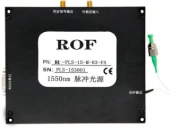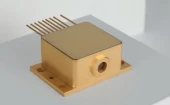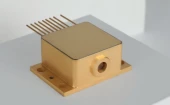Description
The MonoLux Tunable Quantum Cascade Laser System is a cutting-edge solution designed for precision and versatility in various scientific and industrial applications. This system features an advanced wavelength tunable external grating cavity quantum cascade laser, which includes a single QCL. With a wavelength coverage of ±5% around the center wavelength, the MonoLux offers a broader tuning range as an optional feature, making it adaptable to specific user needs. The laser head, which houses the QCL and collimating optics, is meticulously sealed to ensure reliable performance even in challenging environments. The complete system is delivered ready to use, with a laptop-based operating system that can be easily deployed at the customer's location.
Operating in a quasi-CW mode, the MonoLux delivers 200-500 ns pulses at a repetition rate of approximately 500 kHz to 2 MHz, achieving a duty cycle of around 50%. This operation mode allows the QCL to produce an average power output exceeding 500 mW at the center of its tuning curve, contingent on the chosen center wavelength. For applications requiring continuous wave performance, the system can be configured for CW operation with a 100% duty cycle. The passive cooling design eliminates the need for fans, resulting in ultra-quiet operation.
The MonoLux-AA variant offers additional flexibility with its QCW operation at room temperature, featuring pulse durations ranging from 50 ns to 500 ns and a pulse repetition rate between 1 MHz and 2 MHz. Users can specify their desired center wavelength from a selection that includes 3.8 µm, 4.1 µm, 4.5 µm, 4.8 µm, 6.3 µm, 6.8 µm, 7.3 µm, 8.5 µm, 9.5 µm, and 10.2 µm. The system is capable of continuous and repeated scans over the entire tuning range, or step and scan to any wavelength within the range, with tuning speeds of 100 ms for the complete range. Power stability is maintained within ±3% pulse-to-pulse and ±2% average power over extended periods, ensuring consistent performance.
With a compact design, the MonoLux system measures 12 cm in width, 4.5 cm in height, and 13 cm in depth, weighing less than 0.5 kg. The output beam is collimated with a divergence of less than 5 mrad and offers nearly diffraction-limited quality. The system interfaces via USB, requiring a Windows XP or later computer with USB 2.0. This makes the MonoLux an ideal choice for researchers and professionals seeking a reliable, high-performance laser system that is both versatile and user-friendly.
Tunable Monolux Quantum Cascade Laser at 4.8um
Specifications
| Output Power (avg): | 0.5 W |
|---|---|
| Wavelength: | 4.8 um |
| Pulse Duration: | 50 – 500 ns |
| Tuning Range Around Center Wavelength: | >= 300nm |
| Wavelength Range: | um |
| Rep Rate Range: | MHz |
Features
- Tunable Quantum Cascade Laser System: The MonoLux is a wavelength tunable external grating cavity quantum cascade laser system, providing wavelength coverage of ±5% around the center wavelength, with broader tuning ranges available optionally.
- Operation Modes: Operates in quasi-CW mode with 200-500 ns pulses at a repetition rate of ~500 kHz - 2 MHz, achieving a duty cycle of ~50%. Can also operate in CW mode with a 100% duty cycle (optional).
- Power Output: Average power output exceeds 500 mW at the center of its tuning curve, depending on the choice of center wavelength.
- Quiet Operation: The system is passively cooled with no fans, ensuring very quiet operation.
- Wavelength Options: User-specified center wavelengths available at 3.8 µm, 4.1 µm, 4.5 µm, 4.8 µm, 6.3 µm, 6.8 µm, 7.3 µm, 8.5 µm, 9.5 µm, and 10.2 µm.
- Tuning Capabilities: Tunable over the gain bandwidth of the QCL with a tuning speed of 100 ms for the entire range. Offers continuous, repeated scans, and step-and-scan modes.
- Power Output Stability: ±3% pulse-to-pulse and ±2% average power stability over hours.
- Pulse Trigger: Internal or external triggering, with external mode allowing any pulse repetition sequence within a 50% maximum duty cycle.
Applications
- Environmental Monitoring: Use the MonoLux system for precise monitoring of atmospheric gases and pollutants.
- Industrial Process Control: Implement in manufacturing for real-time monitoring and control of chemical processes.
- Medical Diagnostics: Utilize in non-invasive diagnostics by detecting specific biomarkers in breath analysis.
- Scientific Research: Employ in spectroscopy for detailed analysis of molecular compositions in various fields of research.
- Security and Defense: Use for detecting hazardous substances and monitoring secure environments.
- Environmental Science: Conduct research on greenhouse gases and climate change by measuring gas concentrations accurately.
- Pharmaceutical Industry: Apply in the development and quality control of pharmaceutical products through precise measurement of chemical compounds.
- Agricultural Monitoring: Monitor and analyze soil and plant emissions for better crop management and yield prediction.
Frequently Asked Questions
What is the MonoLux Quantum Cascade Laser?
What is the wavelength coverage of the MonoLux Quantum Cascade Laser?
What is the duty cycle of the MonoLux Quantum Cascade Laser?
What is the power output of the MonoLux Quantum Cascade Laser?
What is the cooling system of the MonoLux Quantum Cascade Laser?
Similar Products












Your inquiry has been received.
Create an account by adding a password
Why create an account?
- Auto-complete inquiry forms
- View and manage all your past messages
- Save products to your favorites
- Close your account anytime — no hassle
